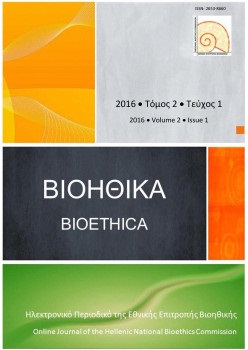Ηθική και Δεοντολογία στη Χρησιμοποίηση Ζώων στη Βιοϊατρική Έρευνα
Abstract
Η χρησιμοποίηση ζωικών προτύπων στη βιοϊατρική έρευνα αποτελεί επιστημονική πρακτική που θεωρείται ότι έχει συμβάλει καθοριστικά στην κατανόηση βασικών βιολογικών λειτουργιών αλλά και στη βελτίωση της ποιότητας της ζωής των ανθρώπων και των ζώων. Για πολλά χρόνια η χρησιμοποίηση των ζώων στη βιοϊατρική έρευνα είχε ανθρωποκεντρικό χαρακτήρα οι δε ερευνητές που χρησιμοποιούσαν ζώα εργαστηρίου τεκμηρίωναν την αναγκαιότητα του πειραματισμού τους βασιζόμενοι κυρίως στα προσδοκούμενα για τον άνθρωπο οφέλη. Κατά τη διάρκεια της τελευταίας εικοσαετίας, η ευαισθητοποίηση της κοινής γνώμης και το ενδιαφέρον των επιστημόνων που ασχολούνται με την υγεία και την ευζωία των ζώων εργαστηρίου έχουν καταστήσει σαφές ότι η χρησιμοποίηση ζώων στη βιοϊατρική έρευνα θα πρέπει να ακολουθεί συγκεκριμένους ηθικούς, νομοθετικούς και επιστημονικούς κανόνες.
Η ηθική τεκμηρίωση μιας ερευνητικής πρότασης θα πρέπει ουσιαστικά να δίνει απαντήσεις σε ερωτήματα που αφορούν κυρίως στον ορισμό των στόχων του ερευνητικού πρωτοκόλλου καθώς και τις αναμενόμενες πιθανότητες επιτυχίας του, στην τεκμηρίωση της αναγκαιότητας για τη χρησιμοποίηση ζώων, στην εφαρμογή της Συνθήκης των 3Rs (Refinement, Reduction, Replacement), στο σχεδιασμό πιλοτικής μελέτης, στη συστηματική ανάλυση και στη δυνατότητα επίτευξης του επιδιωκόμενου στόχου του πρωτοκόλλου με τη διαθέσιμη υλικοτεχνική υποδομή και το απαραίτητο προσωπικό.
Η ηθική τεκμηρίωση του ερευνητικού πρωτοκόλλου αποτελεί δυναμική διαδικασία που αρχίζει από τη φάση του σχεδιασμού του ερευνητικού πρωτοκόλλου και ολοκληρώνεται με την αξιολόγηση και την επεξεργασία των αποτελεσμάτων. Τελικά, το κύριο μήνυμα που θα πρέπει να διαχέεται από την επιστημονική κοινότητα προς την κοινωνία είναι ότι εφ’ όσον η χρησιμοποίηση των ζώων είναι αναπόφευκτη αυτή θα πρέπει να γίνεται με βάση συγκεκριμένα ηθικά, νομοθετικά και επιστημονικά κριτήρια. Με τον τρόπο αυτό θα οικοδομηθεί η σχέση αμοιβαίας εμπιστοσύνης αλλά και εκτίμησης μεταξύ της ερευνητικής κοινότητας και του κοινωνικού συνόλου.
Article Details
- Come citare
-
Κωστομητσόπουλος (Nikolaos Kostomitsopoulos) Ν. (2016). Ηθική και Δεοντολογία στη Χρησιμοποίηση Ζώων στη Βιοϊατρική Έρευνα. Bioethica, 2(1), 16–25. https://doi.org/10.12681/bioeth.19661
- Fascicolo
- V. 2 N. 1 (2016): Bioethica
- Sezione
- Original Articles
Authors who publish with this journal agree to the following terms:
- Authors retain copyright and grant the journal right of first publication with the work simultaneously licensed under a Creative Commons Attribution CC BY 4.0 License, which allows for immediate free access to the work and permits any user to read, download, copy, distribute, print, search, or link to the full texts of articles, crawl them for indexing, pass them as data to software, or use them for any other lawful purpose. Appropriate credit must be given by citing the author(s) and the original publication in this journal.
- Authors are able to enter into separate, additional contractual arrangements for the non-exclusive distribution of the journal's published version of the work (e.g. post it to an institutional repository or publish it in a book), with an acknowledgement of its initial publication in this journal.
We encourage authors to deposit their articles, as well as data underlying the publications, in institutional and/or other appropriate subject repositories.
Bioethica permits and encourages authors to archive the final publication pdf in institutional (e.g. the repository of the National Hellenic Research Foundation) or other appropriate subject repositories (e.g. SSOAR repository for social sciences), in compliance with institutional and/or funder open access policies, after publication in the BIOETHICA. Authors must provide bibliographic details that credit publication in the journal, as well as related funding details (when applicable).
Lists of institutional and other subject-based academic open access repositories can be found listed by country at the registry http://opendoar.org/countrylist.php
If your institution does not possess a repository you may deposit a copy of your paper at no cost with www.zenodo.org , the repository supported for open access research in the EU by the European Commission, through the project OpenAIRE (www.openaire.eu )



